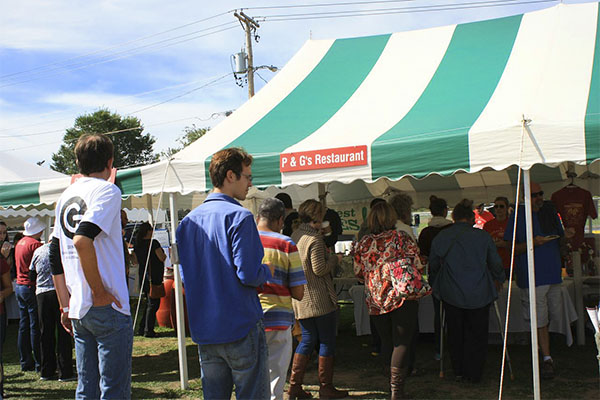

Delectable dishes and mugs of beer overflowed from the tents at Taste of New Paltz, but the trash did not. This year’s food festival marked the start of a dedicated recycling procedure for the day.
In 2012, no one cleaned up properly after the feast and the environment suffered, Michelle Bergkamp, recycling coordinator of the Ulster Country Resource Recovery Agency, said.
Despite more than 5,000 people swarming last year’s festival, the Ulster County Fairgrounds had no recycling bins.
This year, there were nearly 7,000 foodie enthusiasts. But now the first-ever recycling committee had been prepped to dispose of leftovers from Barnaby’s Steakhouse, Mexicali Blue, Asian Fusion and other food and beverage establishments local to the Hudson Valley.
The food vendors made up more than a third of the fair; 90 percent of them were from the New Paltz area. However, with delicious dishes comes waste: wrappers, plastic forks and bottles can leave consumers feeling lost about where to put the trash.
Wendy Toman, a New Paltz resident who works on the recycling committee, took the guesswork out of recycling by placing 12 eco-stations around the fairgrounds. Three volunteers man each station, which consists of compost, landfill and recycling bins.
Each volunteer completes specific training prior to the fair. Most, Toman said, are students from New Paltz Middle School, New Paltz High School and SUNY New Paltz.
“This way, nothing is contaminated,” Toman said. “If something that should go in the landfill goes in the compost instead, you can’t use it.”
On a normal day, waste hauled from Ulster County can total as many as 12 dump trucks of waste, Bergkamp said, without even factoring in trash generated from fairs like the Taste of New Paltz.
Last year, trucks hauled every plate, food scrap and napkin more than 250 miles to join the daily waste dumped at the landfills of Seneca Meadows and High Falls near Syracuse, N.Y.
“The metal cans overflowed with trash. The volunteers struggled to haul them,” Toman said.
This year, the recycling committee calculated that they diverted 76 percent of the waste produced from going to the landfill. Out of the diverted trash, 52 percent of the total waste was composted and 24 percent was recycled.
“Truly, I don’t think it’s been done like this before,” Michael Smith, president of the Ulster County Chamber of Commerce, said.
Smith said the recycling committee is one of 20 subcommittees the Chamber of Commerce forms to help run the event smoothly.
To cut down on landfill contributions, New Paltz restaurant Main Course served corn fritters in biodegradable corn husks instead of styrofoam plates. Some vendors also passed out utensils certified by the Biodegradable Products Institute (BPI). Materials used to make a BPI-certified fork include soybean, corn oil and corn starch. These substances will degrade in a commercial composting facility, unlike typical plastics, which are made with petroleum.
But even substances that will naturally decompose in compost, like food scraps, are often sorted into landfills instead.
“More than 30 percent of waste in the U.S. alone is organic waste,” Toman said. “Organics trapped in landfills don’t have access to sunlight to decompose. It would take years.”
The process is evolving, though. Massachusetts and Vermont have both passed legislation mandating the separation of organic materials for all establishments that produce greater than two tons of waste per week.
Although the fair generates far less trash, Toman said it’s a step in the right direction to cut down on accumulated waste.
The Kingston landfill facility the Ulster County Resource Recovery Agency uses speeds up the process by heating compostable material to 160 degrees to aid in the formation of “soil amendment,” a mineral-rich substance that is later analyzed and purified for pathogens and weeds. The process diverts waste from landfills and reduces the amount of methane gas released into the atmosphere.
“Most people are like, ‘Okay, global warming is bad, but what can I do about it?,’” Toman said. “We show them how. [Composting] is what you can do.”
